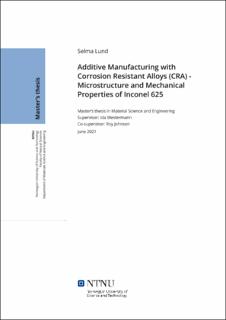| dc.contributor.advisor | Westermann, Ida | |
| dc.contributor.advisor | Johnsen, Roy | |
| dc.contributor.author | Lund, Selma | |
| dc.date.accessioned | 2021-09-28T18:20:28Z | |
| dc.date.available | 2021-09-28T18:20:28Z | |
| dc.date.issued | 2021 | |
| dc.identifier | no.ntnu:inspera:80234703:25572375 | |
| dc.identifier.uri | https://hdl.handle.net/11250/2785334 | |
| dc.description.abstract | Denne masteroppgaven har som mål å bidra til økt forståelse av hvordan additive tilvirknings (AM) teknologier som selektiv lasersmelting (SLM) påvirker mikrostruktur og mekaniske egenskaper av Inconel 625 (IN625), sammenlignet med tradisjonelle produksjonsmetoder. Effekten av ulike varmebehandlinger analyseres for ˚a se hvordan mikrostrukturen påvirkes når det gjelder kornvekst og presipitat-kinetikk, i tillegg til mekaniske egenskapene som strekkfasthet og hardhet. To SLM-produserte IN625-prøver fra forskjellige leverandører analyseres for ˚a se om de samme egenskapene er oppnådd både før og etter varmebehandling. Formålet er ˚a anvende AM som produksjonsmetode i industrier der kravene til materialegenskapene er strenge og pålitelige materialer er avgjørende. Siden Inconel 625 har høy styrke, er det utfordrende ˚a forme. Ved hjelp av additiv produksjonsteknologi kan imidlertid mer komplekse geometrier produseres, noe som bidrar til ˚a redusere vekten av komponenten, samt redusere både tid og kostnader for produksjon. Teknologien er relativt ny og raskt voksende, så det er fortsatt mye usikkerhet om hvordan denne produksjonsmetoden påvirker de mekaniske egenskapene samt korrosjonsmotstanden, siden et helt nytt sett med prosessparametere benyttes. Det observeres også at varmebehandling påvirker AM-prøver på en helt ny måte sammenlignet med trandisjonelt produserte (TM) materialer. Mer kunnskap om de ulike varmebehandlingene er derfor også nødvendig.
To SLM-produserte IN625-materialer ble karakterisert i SEM og TEM etter varmebehandling mellom 850°C og 1100°C. De mikrostrukturelle observasjonene ble sammenlignet med en TM IN625 prøve. Strekktesting ble utført for de tre forskjellige byggeretningene (0°, 45°, 90°) for ˚a se om de mekaniske egenskapene er sammenlignbare med TM-prøven, både før og etter varmebehandlinger. Resultatene av den mikrostrukturelle karakteriseringen viste at AM-prøvene hadde en dendrittisk struktur med langstrakte korn i byggeretningen. Strekktesten viste at AM hadde bedre mekaniske egenskaper enn TM. Imidlertid ble anisotropi i forskjellige retninger observert. Etter spenningsreduksjon (SR) ved 850°C og 900°C ble utfellinger, antatt å være δ fase, dannet i begge AM materialene. Rekrystallisering var nesten fullført ved 1100°C, hvor tvillinger og equiaxed korn ble dannet, noe som resulterte i en struktur som ligner den for TM-prøven. Strekkfastheten ble redusert med en økende varmebehandling, og egenskapene ble observert ˚a være isotrope etter varmebehandling ved 1100°C. | |
| dc.description.abstract | This thesis aims to contribute to an increased understanding of how Additive Manufacturing (AM) technologies such as Selective Laser Melting (SLM) affect the microstructure and mechanical properties of Inconel 625 (IN625), compared to traditional manufacturing methods. The effect of various heat treatments is analyzed to see how the microstructure is affected regarding grain growth and precipitation kinetics, as well as the mechanical properties such as tensile strength and hardness. Two SLM-produced IN625 samples from different vendors are analyzed to see if the same properties are obtained in the samples before and after heat treatment. The purpose is to apply AM as a production method in industries where the requirements of the material properties are strict and reliable materials are essential. Since Inconel 625 has high strength, it is challenging to process. However, by using AM technologies, more complex geometries can be produced, which helps reduce the weight of the component, as well as time and cost of production. The technology is relatively new and rapidly growing, so there are still many uncertainties of how this production method affects the mechanical- and corrosion properties since a whole new set of process parameters are used. It is also observed that heat treatment affects AM samples in a whole new way compared to Traditional Manufacturing (TM). More knowledge of the various heat treatment is also needed.
Two SLM-produced IN625 materials were characterized in SEM and TEM after heat treatment between 850°C and 1100°C. The microstructural observations were compared to a TM sample of IN625. Tensile tests were conducted for the three different build directions (0°, 45°, 90°) to see if the mechanical properties are comparable with the TM sample, both before and after heat treatments. The results of the microstructural characterization showed that the AM samples had a dendritic structure with elongated grains in the build direction. From the tensile tests, it was found that the AM samples had better mechanical properties than the TM material. However, anisotropy in different directions was observed. After Stress Relief (SR) at 850°C and 900°C precipitates, assumed to be δ phase, formed in both AM materials. Recrystallization was almost complete at 1100°C, where twins and equiaxed grains were formed, resulting in a structure similar to the TM sample. Moreover, it was observed that the tensile strength reduced with an increasing heat treatment, and the properties were isotropic after annealing at 1100°C. | |
| dc.language | eng | |
| dc.publisher | NTNU | |
| dc.title | Additive Manufacturing with Corrosion Resistant Alloys (CRA) - Microstructure and Mechanical Properties of Inconel 625 | |
| dc.type | Master thesis | |
